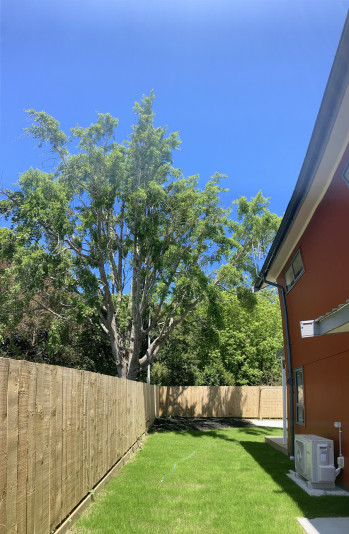Preservation of mature Gingko Biloba tree prioritised during development
22 December 2021
A mature Ginkgo tree that has been standing in Otāhuhu for approximately 35 years has been preserved for residents to enjoy for generations to come.
The leafy Gingko Bilboa straddles the boundary of the recently completed development on Church Street, which now hosts 15 new warm, dry duplex homes.
Large trees sometimes need to be removed to allow redevelopment, during the early phase of development Senior Development Manager Richard Quilter sought the expertise of Peers Brown Miller Arborists to assess the Gingko Biloba tree’s root bulbs and the likely effect of severing the roots at the boundary.

Gingko Biloba tree on Church Street, Otāhuhu.
“It was important for us to keep the tree and implement a retention plan that would ensure the Gingko survived during redevelopment”, says Quilter.
Working in partnership with arborists, his team hand dug the surrounding soil at the base and a planned retaining wall was removed and redesigned, again, to avoid disturbing or penetrating its roots.
Railings were erected to ensure the root preservation area is not dug over together with a sign was hung on the fence to show the significance of the root protection zone.
“It comes down to educating people on root protection zones, and making everyone aware of the area beneath the soil, so they can enjoy the shade it provides for years to come”, says Quilter.
Richard emphasizes the important role existing trees play when developing an area. The social and environmental benefits are great for communities.
“There has been a massive shift in the way we are building and strong emphasis on retaining trees that are irreplaceable in our neighbourhoods.
“I want to make sure we preserve large trees like the Gingko and adopt a best practice approach by complement planting around the homes we build.
“Although the Gingko is not a native New Zealand tree, it is still our responsibility to preserve the established treescapes in our neighbourhoods”, says Quilter.
Kāinga Ora is committed to contributing to the sustainable growth, protection and preservation of urban ngāhere in our communities. The Gingko Biloba is a maidenhair tree or living fossil, it is the world’s oldest living tree and its existence can be traced back 250 million years.
Media Contact
Page updated: 22 December 2021
